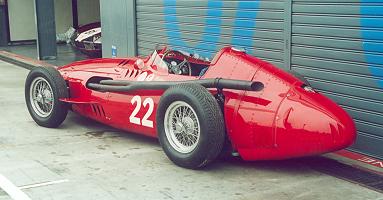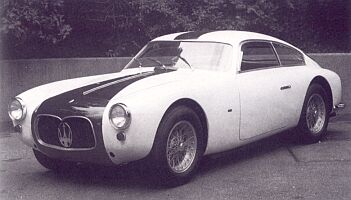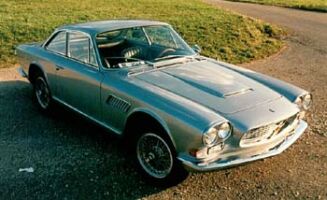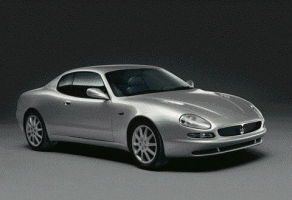It was there that the first race cars were built,
using the chassis' from Isotta-Fraschini coupled with aircraft engines.
Cars from Diatto were also modified for a short time, but the real route
lay in constructing one's own vehicles, and thus they built their first
complete car, with an 8 cylinder dohc in-line 1.5-litre engine fitted with
a Roots supercharger. This car, the 'Tipo 26' was the one which impressed
spectators and competitors alike in the 1926 Targa Florio.
Development continued, and thanks also to the first
clients, the cars grew, first 2-litres, then four speed transmissions,
then 2.5-litres and so on. A V16 broke the 10km land speed record in 1929
which just added to the growing public awareness of the marque. The Tipo
26M continued into Grand Prix racing in 1930, with the engine growing to
2.8-litres for the following season. Apart from the poor financial condition
of the company, it suffered a huge blow in 1932 when Alfieri, the main
driving force behind the cars to date, died, aged only 44. Ernesto, Ettore
and Bindo continued the work with successful models such as the Tipo 8CM
and 6CM emerging under their direction.
In 1937, due to their worsening finances, the brothers
were forced to sell their company to the Orsi family but, as stipulated
in the contract, continued to work with them
In the meantime the business was moved to Modena
and during and after the war the development of the desired road cars began.
The A6 emerged in 1946, followed by the A6G and
the A6G54. These cars were still really a sideline to the motorsport side
of the business, and were used in many races, as well as forming
the basis for more potent competition cars. These years saw the last real
effort in motorsport by the Trident, concentrating on the newly formed
Formula One championship with involvement also in the Sport category. The
early efforts did not succeed as desired, but continual developement saw
the debut in 1956 of the 250F which took the F1 championship in the following
year. In the Sport they also reached the top with the 300S taking many
victories in 1956 and the 450S in 1957.
All this expenditure, however, left the companies
finances even weaker than before and so in 1957 they ceased all motorsport
activities (apart from continuing to support clients). That year also saw
the launch of the first true road car, the 3500GT.
This was a luxury GT coupe and was built in much greater numbers than any
of the preceding models. Later, in 1964, a variant designed by Vignale
became known as the Sebring.
Despite the withdrawal from motorsport, development
of some Sports cars continued, with the famous Birdcage series emerging
first as the front-engined 2-litre Tipo 60 and 2.9-litre Tipo 61, rapidly
replaced by the rear-engined Tipo 63 and 64. For the 1962 Le Mans there
was also born the Tipo 151, but it did not achieve its aim.
Continuing with road cars, the 5000GT
was introduced in 1959, using a quad-cam V8 in a modified 3500GT chassis,
followed by the Mistral in 1963 which used a
further development of the 3500GT 1963 also saw Maserati bring out the first of a new
family of V8 engined cars. The Quattroporte,
as its name suggests, was a large four door high performance saloon. A
shortened and slightly developed chassis was used in the Mexico
of 1965, a two door, 2+2 coupe, and then again in 1967 when the Ghibli
was released with a yet further shortened chassis and a new two-seat body.
The late 1960s saw control of Maserati pass to Citroen
who supported the development of the final variant based on the front engined
V8 chassis, the Indy. This four seat two door coupe
was introduced in 1969. Maserati, with the financial backing of Citroen,
then turned their hand to a mid-engined car, the resulting Bora
appearing at the Geneva Motorshow of 1971. This used a quad-cam alloy V8,
and the following year saw Maserati introduce the Merak,
effectively a Bora powered by a new V6 unit, together with some styling changes.
The Biturbo, introduced
in 1981, pointed the way forward. A two door coupe powered by a new twin-turbo
2-litre V6 engine, the Biturbo drastically increased the volume of cars
produced by Maserati. Continual development saw a Spyder, a four door version
(on a longer wheelbase) and an increase of the engine size to 2.8-litres.
1989 saw two events in the history of Maserati, the first was the release
of the Shamal, a Biturbo-like car but now with a twin-turbo V8 engine,
the second was the purchase by Fiat of 49% of the company. The takeover
was completed in 1998 when Maserati was given to Ferrari to turn around,
a plan which began with the all new 3200GT and continued with the
Quattroporte and then the new coupe, the GranTurismo.
Some sales
figures for Maserati cars from the 1960's and 70's.
 Although Maserati really came to prominence first in 1926 at the Targa Florio (where
Alfieri won his class) their automotive exploits started much earlier.
The eldest brother of the family, Carlo, had built engines and then worked
for Fiat, Bianchi and Isotta-Fraschini before passing away in 1910. In
the latter company he had also found work for some of his brothers, an
interest which continued to grow. In 1914 Alfieri opened a garage where
he specialised in Isotta-Fraschini's and after the war founded a spark-plug
factory initially at Milan, later moving it to Bologna.
Although Maserati really came to prominence first in 1926 at the Targa Florio (where
Alfieri won his class) their automotive exploits started much earlier.
The eldest brother of the family, Carlo, had built engines and then worked
for Fiat, Bianchi and Isotta-Fraschini before passing away in 1910. In
the latter company he had also found work for some of his brothers, an
interest which continued to grow. In 1914 Alfieri opened a garage where
he specialised in Isotta-Fraschini's and after the war founded a spark-plug
factory initially at Milan, later moving it to Bologna.
 for ten years. The Orsi family wanted to build road cars, and thus the families
fell out, the Maserati brothers leaving in 1947 to found OSCA. Note should
be made of the 1939 and 1940 victories at the Indianapolis 500 with the
8CTF, a 3-litre eight cylinder with twin superchargers. They remain the
only Indianapolis victories by an Italian marque.
for ten years. The Orsi family wanted to build road cars, and thus the families
fell out, the Maserati brothers leaving in 1947 to found OSCA. Note should
be made of the 1939 and 1940 victories at the Indianapolis 500 with the
8CTF, a 3-litre eight cylinder with twin superchargers. They remain the
only Indianapolis victories by an Italian marque.
 chassis
with larger 3.7 or 4.0-litre six cylinder engines.
chassis
with larger 3.7 or 4.0-litre six cylinder engines.
 In 1974 the next car, the Khamsin (designed to
replace the Ghibli) returned to the front engine rear drive layout combined
with a Gandini designed two door 2+2 coupe body. At around the same time
a new four door saloon, the Quattroporte II, was developed with a strong
Citroen influence, but in 1975 Citroen relinquished control of Maserati,
which went into receivership, and the Quattroporte II died. Shortly afterwards
De
Tomaso took control and began a revival of the marque. A Quattroporte
III was released (which continued in production, with much development
until the late 1990s) and then came the first new car, the Kyalami.
This was actually a revised De Tomaso Longchamps with a Maserati engine
and filled the gap until new cars could be developed.
In 1974 the next car, the Khamsin (designed to
replace the Ghibli) returned to the front engine rear drive layout combined
with a Gandini designed two door 2+2 coupe body. At around the same time
a new four door saloon, the Quattroporte II, was developed with a strong
Citroen influence, but in 1975 Citroen relinquished control of Maserati,
which went into receivership, and the Quattroporte II died. Shortly afterwards
De
Tomaso took control and began a revival of the marque. A Quattroporte
III was released (which continued in production, with much development
until the late 1990s) and then came the first new car, the Kyalami.
This was actually a revised De Tomaso Longchamps with a Maserati engine
and filled the gap until new cars could be developed.
You can see more pictures of historical Maserati cars at our
Bonfanti Museum Maserati Exhibition page
Ferrari and Maserati at Monza event page
Plus several events galleries also feature some Maserati cars, such as the Silver
Flag and the 2001 Mille Miglia.
Copyright © 2000 to 2008 CarsfromItaly